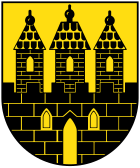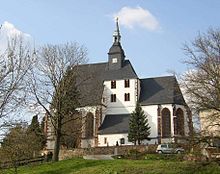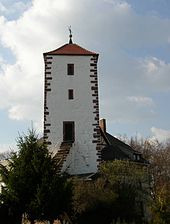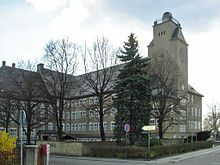Geithain
| coat of arms | Germany map | |
|---|---|---|

|
Coordinates: 51 ° 3 ' N , 12 ° 41' E |
|
| Basic data | ||
| State : | Saxony | |
| County : | Leipzig | |
| Height : | 225 m above sea level NHN | |
| Area : | 54.71 km 2 | |
| Residents: | 6858 (Dec. 31, 2019) | |
| Population density : | 125 inhabitants per km 2 | |
| Postal code : | 04643 | |
| Primaries : | 034341, 034346 | |
| License plate : | L , BNA, GHA, GRM, MTL, WUR | |
| Community key : | 14 7 29 150 | |
| LOCODE : | DE GTH | |
| City structure: | 10 districts | |
City administration address : |
Markt 11 04643 Geithain |
|
| Website : | ||
| Mayor : | Frank Rudolph (UWG) | |
| Location of the city of Geithain in the Leipzig district | ||
Geithain (colloquially: Geidn) is a large district town in the south of the Leipzig district .
geography
Geithain is located in the Saxon hill country , on the Eula stream that rises in the nearby Wickershain forest .
Name and breakdown by location
The origin of the place name is seen in the Old Sorbian word "Chyten, Chytan", a personal name. In addition to the core city, the following places belong to the city of Geithain (date of incorporation in brackets):
- Altdorf (April 1, 1934)
- Mark Ottenhain (1875)
- Narsdorf (July 1, 2017) with Dölitzsch (July 1, 1973 to Narsdorf) and Seifersdorf (April 1, 1934 to Narsdorf)
- Nauenhain (July 1, 1995)
- Niedergräfenhain (January 1, 1994)
- Ossa (October 1, 1996 to Narsdorf) with Bruchheim (October 1, 1948 to Ossa), Kolka (October 1, 1948 to Ossa) and Wenigossa (October 1, 1948 to Ossa) with Niederpickenhain (October 1, 1935 to Wenigossa)
- Rathendorf (October 1, 1996 to Narsdorf) with Oberpickenhain (1956 to Rathendorf)
- Syhra (March 1, 1994) with Theusdorf (April 1, 1935 to Syhra)
- Wickershain (January 1, 1974)
history
From prehistoric times, only one settlement of culture with stitched ceramics is known. In the Bronze and Iron Ages, the surrounding area was apparently uninhabited.
Geithain comes into the light of the written tradition in 1186 in a deed which recorded the donation of the income from the Wickershain Marienkirche by Count Dedo von Rochlitz to the Merseburg bishop , to whose district it belonged. The name Geithain has its roots in the Old Sorbian * Chyten (Chytan) and denotes the place of a person named * Chyt (Chit) .

The oldest early urban settlement in the urban area was probably a merchant settlement below the Nikolaikirche, as it existed, for example, in Rochlitz and other Saxon cities. It was on a trade route leading from Altenburg via Colditz to Leisnig .
In 1209, the town and Nikolaikirche were named again in a document when Margrave Conrad II von Landsberg ordered the creation of a hospital and a St. James chapel in the city. The establishment of the right-hand town around the elongated street market, which in turn has a parallel in the nearby, roughly equal old town of Rochlitz, must have been made around 1200. However, a council constitution can only be proven for the year 1335.
In the middle and second half of the 14th century, the city and the surrounding area flourished under Margrave Wilhelm I the One-Eyed . Geithain was administered in the Middle Ages by a bailiff , who had his seat in the Freihof, first mentioned in 1349. The Geithainer Pulverturm, today one of the city's sights, was part of the Freihof and, together with it, was integrated into the city fortifications.
Around 1349/50 there is talk of a "curia et castrum", a courtyard and a castle, in connection with the city. In 1357 Geithain was granted the privilege to produce canvas . In 1392 Geithain acquired the lower and in 1467 the upper jurisdiction . Geithain's oldest town seal dates from 1416 and in 1904 became the basis for the town's coat of arms, which is still in use today. Before 1377, a supraregional jury chair was set up in Geithain , which also passed judgments for neighboring cities. This right was confirmed to the Geithain jury in 1432 by the sovereign. From 1499 three annual fairs were held. In the second half of the 15th and the first half of the 16th centuries, several guilds were first named in writing and given privileges. After a brewery had already been built in 1529, Elector Moritz granted the city the right to brew in 1553 .
Under Duke Heinrich the Pious , Albertine Saxony turned to Luther's teachings in 1539 and 1540 . The Reformation was therefore also introduced in Geithain on the 1st of Advent 1539 . In the year 1551 a "Geistige Vorsteherei" is attested for the city, to which nine parishes belonged.
The Thirty Years' War also affected Geithain. The city was looted a total of seventeen times during this war. In 1641 the city council's police regulations were introduced as the norm of the city's criminal law with 48 do's and don'ts. After Elector Johann Georg III. When a standing army was introduced in the Electorate of Saxony in 1683 , the city became a garrison location (only from 1690). In the course of the survey of the Electorate of Saxony under Augustus the Strong , two post mile columns were set up in Geithain in 1727 .
In 1833 a civil town order was introduced in Geithain. At that time the city had around 3000 inhabitants, including 64 linen weavers, 26 tailors, 146 other craftsmen and day laborers. In 1861, freedom of trade was issued in the Kingdom of Saxony. As a result, the old guilds of linen weavers, tanners, rope makers, furriers and cooperatives dissolved in Geithain. In the same year the first edition of the newspaper "Geithainer Wochenblatt" appeared, which was published until 1943. Until 1856, Geithain was in the Electoral Saxon or Royal Saxon Office of Rochlitz . From 1856 the place belonged to the Geithain court office and from 1875 to the Borna district administration .
After the construction of the station building began in 1869, it was connected to the Saxon-Bavarian railway network on April 8, 1872 with the opening of the Neukieritzsch – Chemnitz railway line. Finally, in 1887, the Leipzig – Geithain – Chemnitz line was opened. With the withdrawal of the 2nd Royal Saxon Uhlan Regiment No. 18 to Leipzig, the city's 200-year garrison period ended in 1897. In the former riding hall of the Geithain garrison, the Geithain enamelling factory was built in 1898.
The Paul Guenther School was inaugurated on October 29, 1925. With its 36 m high tower it is one of the most striking points in the silhouette of this city today. The school was built at the suggestion of the school director Louis Petermann (honorary citizen of the city, born August 13, 1870 - March 22, 1964), who, in view of the poor spatial and structural conditions in the old school building, turned to Paul Guenther with a request for a school to be founded turned.
In the Second World War the city lost 219 people. 13 people were killed in the only air raid on the city on April 13, 1945. The target of the low-flying aircraft in this attack was the train station. On April 14, 1945, the Second World War ended for Geithain with the arrival of American troops.
In the course of the administrative reform in the GDR , Geithain became the district town of the Geithain district in the Leipzig district in 1952 .
On June 17, 1953, the Geithain resident Eberhard v. Cancrin, father of two underage daughters, arrested at his place of work at the Espenhain plant and probably shot dead by the NKVD the following night. The widow only received news of his death six weeks after the husband's disappearance when the urn was handed over. Cancrin's fate was a GDR state secret for decades.
In 1969, after a two-year construction period, the municipal outdoor pool was opened. In the same year the polyclinic was inaugurated. In 1986 the citizens of Geithain celebrated the city's 800th anniversary. The political change began in Geithain with the Reformation service on October 31, 1989 and the demonstration that followed .
Geithain lost its status as a district town on August 1, 1994 with the creation of the Leipziger Land district. On January 1, 2020, it received the status of a major district town.
On January 1, 2002, the Narsdorf community merged with Geithain to form an administrative community. On July 1, 2017 Narsdorf was incorporated into Geithain and the administrative community was dissolved.
- Incorporations
| Former parish | date | annotation |
|---|---|---|
| Altdorf | April 1, 1934 | |
| Bruchheim | October 1, 1948 | Incorporation to Ossa |
| Dolitzsch | July 1, 1973 | Incorporation to Narsdorf |
| Kolka | October 1, 1948 | Incorporation to Ossa |
| Mark Ottenhain | before 1880 | |
| Narsdorf | July 1, 2017 | |
| Nauenhain | July 1, 1995 | |
| Niedergräfenhain | January 1, 1994 | |
| Niederpickenhain | April 1, 1935 | Incorporation to Wenigossa |
| Oberpickenhain | 1956 | Incorporation to Rathendorf |
| Ossa | October 1, 1996 | Incorporation to Narsdorf |
| Rathendorf | October 1, 1996 | Incorporation to Narsdorf |
| Seifersdorf | April 1, 1934 | Incorporation to Narsdorf |
| Syhra | March 1, 1994 | |
| Theusdorf | April 1, 1935 | Incorporation to Syhra |
| Wenigossa | October 1, 1948 | Incorporation to Ossa |
| Wickershain | 1st January 1974 |
politics
coat of arms
Description : A continuous, black, gold-grooved crenellated wall in gold with three attached towers, pointed roofs with knobs and one window each with daylight. Two open windows are also in the wall next to an open passage.
City council
The local elections on May 25, 2014, with a turnout of 53.00%, led to the following result for the composition of the Geithain City Council:
| Party / list | CDU | UWG | left | FDP | NPD | WVWV * | total |
|---|---|---|---|---|---|---|---|
| Seats | 5 seats | 6 seats | 3 seats | 0 seats | 2 seats | 2 seats | 18 seats |
| be right | 2031 | 2221 | 1303 | 134 | 729 | 876 | 7294 |
* Association of voters to safeguard the interests of the association
Town twinning
Veitshöchheim in Lower Franconia (Bavaria) has been the twin town of Geithain since 1990 .
Economy and Infrastructure
Established businesses
- Society for enamelling and surface technology (GEO) mbH
- Musikelektronik Geithain GmbH (studio technology, sound engineering)
- Puschendorf Textilservice GmbH, GETEX Geithain branch
- Holzwerke Ladenburger
traffic
Streets
The federal road 7 runs through the village . In addition, Geithain is connected directly to the A 72 via the junction of the same name west of Niedergräfenhain .
Rail transport
Geithain owns a station on the Leipzig - Neukieritzsch - Borna - Chemnitz railway line, which has been electrified up to this point . The Leipzig - Bad Lausick - Geithain line also joins the Geithain station .
There are hourly, fast connections from Geithain with the RegionalExpress RE 6 of the Central German Regiobahn (MRB) to Leipzig via Bad Lausick and to Chemnitz via Burgstädt . In addition, the RB 113 line of the DB Regio Südost connects Geithain and Leipzig every hour with stops in smaller towns.
Since the commissioning of the Leipzig City Tunnel in December 2013, Geithain has been integrated into the network of the Central German S-Bahn .
| line | Train run | Cycle (min.) |
|---|---|---|
| S 6 | Leipzig Messe - L. Essener Straße - L. Nord - Leipzig Hbf (deep) - L. Markt - L. Wilhelm-Leuschner-Platz - L. Bayerischer Bahnhof - L. MDR - Leipzig-Connewitz - Markkleeberg Nord - Markkleeberg - Markkleeberg- Großstädteln - Markkleeberg-Gaschwitz - Großdeuben - Böhlen (near Leipzig) - Böhlen Werke - Neukieritzsch - Lobstädt - Borna (near Leipzig) - Petergrube - Neukirchen-Wyhra - Frohburg - Geithain stop at the stops at Böhlen Werke, Petergrube and Neukirchen-Wyhra. |
60 |
| RB 113 | Leipzig Hbf - L.-Paunsdorf - L. Werkstättenstraße - L.-Mölkau - L.-Holzhausen - L.-Liebertwolkwitz - Großpösna - Oberholz - Belgershain - Otterwisch - Lauterbach-Steinbach - Bad Lausick - Hofgarten (Sachs) - Tautenhain - Geithain | 60 |
| RE 6 | Leipzig Hbf - Bad Lausick - Geithain - Narsdorf - Burgstädt - Chemnitz Hbf | 60 |
The local authority responsible for local rail passenger transport, and thus responsible for the design of the local transport offer, is the association for the Leipzig local transport area .
The entire local rail passenger traffic and the road-bound public local passenger traffic in and around Geithain are tariff integrated as zone 154 in the Central German Transport Association .
Public facilities
- Paul Guenther School (elementary and high school , community school), named after its founder, the industrialist Paul Guenther
- Children's and youth center "R9" Geithain
- Geithain community center
- International private high school Geithain (IGG)
- Geithain City Library
- Local museum
- outdoor pool
- Animal park
Attractions
- City wall with round bastions and preserved lower city gate
- Local museum
- Romanesque-Gothic Nikolaikirche with splendid interior design
- Marienkirche
- Customs house on the Siegfried Line
- Powder Tower (officially free tower, as it belonged to the noble Freihof )
- Powder mill
- town hall
- Underground passages under the area of the Nikolaikirche
- War memorial
- Barometer house
- medieval residential tower at the old rectory, in it the so-called "Kalandstube" with several wall paintings dated from 1562 (inscription), u. a. three topless young women
- Electoral Saxon post distance column at the former Obertor and similar post mile column or abducted royal Saxon whole milestone in the park at the still preserved Untertor as well as the redesigned royal Saxon station stone at the original location in front of the petrol station
- Geithain-Sommerhof, Am Kalkweg 10, oldest partially preserved Hoffmann ring kiln in Saxony - for burning lime or bricks - according to the Hoffmann / Licht patent , commissioned on July 20, 1869, in 1870 the Saxon King Johann visited this here during a visit to Geithain erect ring furnace. Used until 1910 (partial demolition), preserved without chimney, restored; and the remains of two ovens near Geithain train station.
- District Syhra : Manor and Castle Syhra with gatehouse, threatened with decay
- District Ossa : Remains of the manor Ossa with preserved manor house or gatehouse
- Rathendorf district : Slavic or early German castle wall
Tower of a former aristocratic courtyard , later used as a powder tower for the city fortifications
former customs house on the Siegfried Line in Geithain
sons and daughters of the town
- Nikolaus von Bibra (Nicolaus de Gyten) was born around 1245 and died after 1307 in Erfurt. His place of birth is controversial, but he writes about himself: " You who are from Geithain ". He studied in Padua and Paris and was sometimes referred to as Occultus Erfordensis (the hidden one from Erfurt) because he wrote his poetry cycle of 2,449 lines anonymously.
- Benjamin Hederich , born December 12, 1675 in Geithain, died in Großenhain July 19, 1748
- Christian Gottlieb Berger (1764–1829), superintendent in Eisleben
- Paul Guenther , American industrialist of German descent , born on May 13, 1860 in Geithain, died on January 17, 1932 in Dover / N. J., emigrated to the USA in 1890, largest stocking manufacturer in the USA in 1910, factories u. a. in Dover, New Jersey, gave his hometown Geithain a school in 1925, which has been named after him since 1925, with interruptions from 1976 to 1990.
- Walter Risse (1892–1965), officer, most recently lieutenant general in World War II
- Henning Frenzel (* 1942 in Geithain), former national soccer player in the GDR
- Roland Hammer (* 1952 in Geithain), football player in the GDR league for 1. FC Lokomotive Leipzig and BSG Chemie Böhlen
literature
- Wolfgang Reuter: Chronicle of the city of Geithain. Part 1. From the beginning up to 1634. Dedo-Verlag Geithain 2001. ISBN 3-00-008522-X . Part 2. From 1635 to the inflation of 1923. Dedo-Verlag Geithain 2003. ISBN 3-00-008522-X .
- Gottfried Senf: Chronicle of the city of Geithain, part 3, from 1924 to 2000. Bookstore "Books, Pictures & Music", Geithain, Geithain 2010,
- Gottfried Senf: Geithain Journal, contributions to town and school history. Part 1 to 3, “Books, Pictures & Music” bookstore, Geithain
- Richard Steche : Geithain. In: Descriptive representation of the older architectural and art monuments of the Kingdom of Saxony. 15. Issue: Amtshauptmannschaft Borna . CC Meinhold, Dresden 1891, p. 26.
- An extensive tradition of the Geithain City Court for the period 1606–1868 on court and local administration, criminal, civil and voluntary jurisdiction, church, school and feudal matters, replacements, court books and court records as well as the weavers' guild is in the Saxon State Archives, State Archives Leipzig, inventory 20605 City of Geithain (City Court).
Web links
- Community website
- Geithain in the Digital Historical Directory of Saxony
- Website of the Ev.-Luth. Geithainer Land parish
- Finding aid 20605 City of Geithain (City Court)
Individual evidence
- ↑ Population of the Free State of Saxony by municipalities on December 31, 2019 ( help on this ).
- ^ Ernst Eichler and Hans Walther : Saxony. All city names and their history , Faber and Faber Verlag, Leipzig 2007, ISBN 978-3-86730-038-4 , p. 64
- ^ Karlheinz Blaschke , Uwe Ulrich Jäschke : Kursächsischer Ämteratlas. Leipzig 2009, ISBN 978-3-937386-14-0 ; P. 58 f.
- ^ The Borna District Administration in the municipal directory 1900
- ↑ www.17juni53.de: Eberhard von Cancrin . Last accessed on August 15, 2019
- ↑ Geithain will be »Large District Town« from January 2020. Retrieved July 6, 2020 .
- ↑ a b c d e The Saxony Book, Kommunal-Verlag Sachsen KG, Dresden, 1943
- ↑ a b c d e f Federal Statistical Office (Ed.): Municipalities 1994 and their changes since 01.01.1948 in the new federal states . Metzler-Poeschel, Stuttgart 1995, ISBN 3-8246-0321-7 .
- ↑ a b c d e State Statistical Office of the Free State of Saxony: Area changes
- ↑ City council election 2019
- ↑ Right-wing extremists use free lists in local parliaments
- ↑ Information board on the stove at Gasthof Sommerhof, Geithain, Am Kalkweg 10, Saxony, 2020
- ↑ Ring oven in Geithain-Sommerhof
- ^ City of Geithain (City Court). In: State Archives Leipzig. Retrieved March 26, 2020 . (Info text on the Geithain City Court under "Introduction")

















